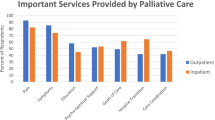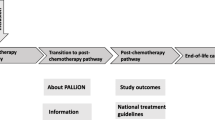Abstract
Purpose
Despite clear benefits of early integration of palliative care (PC) and oncology, concerns remain about negative perceptions of PC. Our aim was to explore current knowledge and perceptions of PC in cancer patients.
Methods
We conducted a prospective, cross-sectional survey. A 16-item questionnaire was distributed to all cancer patients (N = 103) upon admission to the oncology ward of an Australian tertiary academic hospital. Chi-squared test was used to examine for significant factors related to patients’ perceptions.
Results
Ninety-six patients (93%) completed the questionnaire; 76% had metastatic cancer. We explored the following domains:
Experience and knowledge: 76% had heard of PC; 21% had received PC. Self-rated PC knowledge was varied. Forty-five percent believed that PC was only associated with EOLC; those more likely to disagree had received PC services (p = 0.039).
Integration of PC and oncology: Majority believed that they could receive oncology care (86%) and anti-cancer treatment (81%) whilst receiving PC. Those who had heard of PC and with better self-rated knowledge were more likely to believe that they could receive concurrent anti-cancer treatment (p = 0.005, p = 0.045, respectively).
Feelings: 77% felt comforted with PC involvement; this was significantly associated with older age (p = 0.047) and understanding that oncology (p < 0.005) and anti-cancer treatment (p = 0.013) could continue. However, some felt frightened (40%) and hopeless (29%) about referral to PC. Fifty percent felt more comfortable with referral to ‘supportive care’ services (versus PC).
Conclusions
Our survey demonstrates reasonable understanding and relatively positive feelings about PC, associated with experience and knowledge. Nonetheless, there is ongoing need for better patient and public education about PC.
Similar content being viewed by others
References
World Health Organization: Cancer (2018) WHO Definition of PC; cited 2018 Oct 8. Available from: http://www.who.int/cancer/palliative/definition/en/
Temel JS, Greer JA, Muzikansky A, Gallagher ER, Admane S, Jackson VA, Dahlin CM, Blinderman CD, Jacobsen J, Pirl WF, Billings JA, Lynch TJ (2010) Early palliative care for patients with metastatic non-small-cell lung cancer. N Engl J Med 363:733–742
Bakitas M, Lyons KD, Hegel MT, Balan S, Brokaw FC, Seville J, Hull JG, Li Z, Tosteson TD, Byock IR, Ahles TA (2009) Effects of a palliative care intervention on clinical outcomes in patients with advanced cancer: the Project ENABLE II randomized controlled trial. JAMA 302:741–749
Zimmermann C, Swami N, Krzyzanowska M, Hannon B, Leighl N, Oza A, Moore M, Rydall A, Rodin G, Tannock I, Donner A, Lo C (2014) Early palliative care for patients with advanced cancer: a cluster-randomised controlled trial. Lancet 383:1721–1730
Strasser F, Sweeney C, Willey J, Benisch-Tolley S, Palmer JL, Bruera E (2004) Impact of a half-day multidisciplinary symptom control and palliative care outpatient clinic in a comprehensive cancer center on recommendations, symptom intensity, and patient satisfaction: a retrospective descriptive study. J Pain Symptom Manag 27:481–491
McDonald J, Swami N, Hannon B, Lo C, Pope A, Oza A, Leighl N, Krzyzanowska MK, Rodin G, le LW, Zimmermann C (2017) Impact of early palliative care on caregivers of patients with advanced cancer: cluster randomised trial. Ann Oncol 28:163–168
Greer JA, Pirl WF, Jackson VA, Muzikansky A, Lennes IT, Heist RS, Gallagher ER, Temel JS (2012) Effect of early palliative care on chemotherapy use and end-of-life care in patients with metastatic non-small-cell lung cancer. J Clin Oncol 30:394–400
Rozman LM, Campolina AG, Lopez RVM et al (2018) Early palliative care and its impact on end-of-life care for cancer patients in Brazil. J Palliat Med 21:659–664
Fitzpatrick J, Mavissakalian M, Luciani T, Xu Y, Mazurek A (2018) Economic impact of early inpatient palliative care intervention in a community hospital setting. J Palliat Med 21:933–939
El-Jawahri A, Greer JA, Pirl WF et al (2017) Effects of early integrated palliative care on caregivers of patients with lung and gastrointestinal cancer: a randomized clinical trial. Oncologist 22:1528–1534
Hui D, Kim SH, Kwon JH, Tanco KC, Zhang T, Kang JH, Rhondali W, Chisholm G, Bruera E (2012) Access to palliative care among patients treated at a comprehensive cancer center. Oncologist 17:1574–1580
Kamel G, Paniagua M, Uppalapati A (2015) Palliative care in the intensive care unit: are residents well trained to provide optimal care to critically ill patients? Am J Hosp Palliat Care 32:758–762
Wentlandt K, Krzyzanowska MK, Swami N, Rodin GM, le LW, Zimmermann C (2012) Referral practices of oncologists to specialized palliative care. J Clin Oncol 30:4380–4386
Love A, Liversage LM (2014) Barriers to accessing palliative care: a review of the literature. Prog Palliat Care 22:9–19
Maciasz RM, Arnold RM, Chu E, Park SY, White DB, Vater LB, Schenker Y (2013) Does it matter what you call it? A randomized trial of language used to describe palliative care services. Support Care Cancer 21:3411–3419
Miyashita M, Hirai K, Morita T, Sanjo M, Uchitomi Y (2008) Barriers to referral to inpatient palliative care units in Japan: a qualitative survey with content analysis. Support Care Cancer 16:217–222
Morstad Boldt A, Yusuf F, Himelstein BP (2006) Perceptions of the term palliative care. J Palliat Med 9:1128–1136
Aldridge MD, Hasselaar J, Garralda E, van der Eerden M, Stevenson D, McKendrick K, Centeno C, Meier DE (2016) Education, implementation, and policy barriers to greater integration of palliative care: a literature review. Palliat Med 30:224–239
Fadul N, Elsayem A, Palmer JL, del Fabbro E, Swint K, Li Z, Poulter V, Bruera E (2009) Supportive versus palliative care: what’s in a name?: a survey of medical oncologists and midlevel providers at a comprehensive cancer center. Cancer 115:2013–2021
Kavalieratos D, Mitchell EM, Carey TS et al (2014) “Not the ‘grim reaper service’”: an assessment of provider knowledge, attitudes, and perceptions regarding palliative care referral barriers in heart failure. J Am Heart Assoc 3:e000544
Milne D, Jefford M, Schofield P, Aranda S (2013) Appropriate, timely referral to palliative care services: a name change will not help. J Clin Oncol 31:2055
Shalev A, Phongtankuel V, Kozlov E, Shen MJ, Adelman RD, Reid MC (2018) Awareness and misperceptions of hospice and palliative care: a population-based survey study. Am J Hosp Palliat Care 35:431–439
Center to Advance Palliative Care (2011) 2011 Public Opinion Research on PC. Center to Advance Palliative Care; [cited 2019 Jan 19]. Available from: https://media.capc.org/filer_public/18/ab/18ab708c-f835-4380-921d-fbf729702e36/2011-public-opinion-research-on-palliative-care.pdf
Zimmermann C, Swami N, Krzyzanowska M, Leighl N, Rydall A, Rodin G, Tannock I, Hannon B (2016) Perceptions of palliative care among patients with advanced cancer and their caregivers. CMAJ 188:E217–E227
Stjernsward J, Foley KM, Ferris FD (2007) The public health strategy for palliative care. J Pain Symptom Manag 33:486–493
Von Roenn JH, Voltz R, Serrie A (2013) Barriers and approaches to the successful integration of palliative care and oncology practice. J Natl Compr Cancer Netw 11(Suppl 1):S11–S16
Cherny NI (2009) Stigma associated with “palliative care”: getting around it or getting over it. Cancer 115:1808–1812
Dalal S, Palla S, Hui D, Nguyen L, Chacko R, Li Z, Fadul N, Scott C, Thornton V, Coldman B, Amin Y, Bruera E (2011) Association between a name change from palliative to supportive care and the timing of patient referrals at a comprehensive cancer center. Oncologist 16:105–111
Fassbender K, Watanabe SM (2015) Early palliative care and its translation into oncology practice in Canada: barriers and challenges. Ann Palliat Med 4:135–149
McIlfatrick S, Noble H, McCorry NK et al (2014) Exploring public awareness and perceptions of palliative care: a qualitative study. Palliat Med 28:273–280
Collins A, McLachlan SA, Philip J (2017) Initial perceptions of palliative care: an exploratory qualitative study of patients with advanced cancer and their family caregivers. Palliat Med 31:825–832
Collins A, McLachlan SA, Philip J (2018) Communication about palliative care: a phenomenological study exploring patient views and responses to its discussion. Palliat Med 32:133–142
Collins A, McLachlan SA, Philip J (2018) How should we talk about palliative care, death and dying? A qualitative study exploring perspectives from caregivers of people with advanced cancer. Palliat Med 32:861–869
Weil J, Weiland TJ, Lane H, Jelinek GA, Boughey M, Marck CH, Philip J (2015) What's in a name? A qualitative exploration of what is understood by “palliative care” in the emergency department. Palliat Med 29:293–301
Australian Government: The Department of Health (2003) Community Attitudes to PC Issues 2003. Department of Health and Aged Care, Canberra 62 p
Jordan K, Aapro M, Kaasa S, Ripamonti CI, Scotté F, Strasser F, Young A, Bruera E, Herrstedt J, Keefe D, Laird B, Walsh D, Douillard JY, Cervantes A (2018) European Society for Medical Oncology (ESMO) position paper on supportive and palliative care. Ann Oncol 29:36–43
Smith TJ, Temin S, Alesi ER, Abernethy AP, Balboni TA, Basch EM, Ferrell BR, Loscalzo M, Meier DE, Paice JA, Peppercorn JM, Somerfield M, Stovall E, von Roenn JH (2012) American Society of Clinical Oncology provisional clinical opinion: the integration of palliative care into standard oncology care. J Clin Oncol 30:880–887
Berendt J, Stiel S, Simon ST, Schmitz A, van Oorschot B, Stachura P, Ostgathe C (2016) Integrating palliative care into comprehensive cancer centers: consensus-based development of best practice recommendations. Oncologist 21:1241–1249
European Society of Medical Oncology (2018) ESMO, Lugano. ESMO Designated Centres of Integrated Oncology & PC; 2018 [cited 2019, Jan 19]. Available from: https://www.esmo.org/Patients/Designated-Centres-of-Integrated-Oncology-and-Palliative-Care
Lane T, Ramadurai D, Simonetti J (2018) Public awareness and perceptions of palliative and comfort care. Am J Med
Jamwal NR, Kumar SP (2016) Maintaining the social flow of evidence-informed palliative care: use and misuse of YouTube. Indian J Palliat Care 22:104–107
Rhondali W, Burt S, Wittenberg-Lyles E, Bruera E, Dalal S (2013) Medical oncologists’ perception of palliative care programs and the impact of name change to supportive care on communication with patients during the referral process. A qualitative study. Palliat Support Care 11:397–404
Hui D, De La Cruz M, Mori M et al (2013) Concepts and definitions for “supportive care,” “best supportive care,” “palliative care,” and “hospice care” in the published literature, dictionaries, and textbooks. Support Care Cancer 21:659–685
Matsuyama RK, Balliet W, Ingram K, Lyckholm LJ, Wilson-Genderson M, Smith TJ (2011) Will patients want hospice or palliative care if they do not know what it is? J Hosp Palliat Nurs 13:41–46
Kaasa S, Loge JH, Aapro M, Albreht T, Anderson R, Bruera E, Brunelli C, Caraceni A, Cervantes A, Currow DC, Deliens L, Fallon M, Gómez-Batiste X, Grotmol KS, Hannon B, Haugen DF, Higginson IJ, Hjermstad MJ, Hui D, Jordan K, Kurita GP, Larkin PJ, Miccinesi G, Nauck F, Pribakovic R, Rodin G, Sjøgren P, Stone P, Zimmermann C, Lundeby T (2018) Integration of oncology and palliative care: a lancet oncology commission. Lancet Oncol 19:e588–e653
Acknowledgements
The authors thank Mr. M Gotch and Ms. A Bounds (palliative care nurse consultants) for assistance with survey administration.
Funding
No financial support was received for this study.
Author information
Authors and Affiliations
Contributions
• BC: Conceptualization, data curation, formal analysis, methodology, writing – original draft, writing – review and editing
• MB: Conceptualization, data curation, formal analysis, methodology, writing – original draft, writing – review and editing
• AE: Formal analysis, methodology
• MF: Writing – review and editing
• FR: Writing – review and editing
• LW: Writing – review and editing
• PP: Writing – review and editing
• JY: Conceptualization, data curation, formal analysis, methodology, project administration, resources, supervision, validation, visualization, writing – original draft, writing – review and editing
Corresponding author
Ethics declarations
Conflict of interest
The authors declare that they have no conflict of interest.
Data
The research team have full control of all primary data and agree to allow the journal to review their data if requested.
Additional information
Publisher’s note
Springer Nature remains neutral with regard to jurisdictional claims in published maps and institutional affiliations.
Electronic supplementary material
ESM 1
(DOCX 85 kb)
Rights and permissions
About this article
Cite this article
Chosich, B., Burgess, M., Earnest, A. et al. Cancer patients’ perceptions of palliative care. Support Care Cancer 28, 1207–1214 (2020). https://doi.org/10.1007/s00520-019-04917-8
Received:
Accepted:
Published:
Issue Date:
DOI: https://doi.org/10.1007/s00520-019-04917-8




